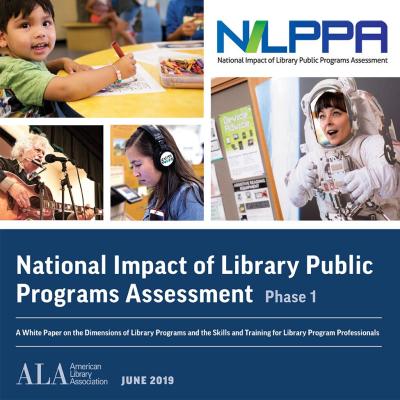The ALA Public Programs Office has released a report outlining the findings of an intensive research study that explored the characteristics, audiences, outcomes and value of U.S. library programming, as well as the competencies required to succeed in the field.

The report, “National Impact of Library Public Programs Assessment: Phase 1: A White Paper on the Dimensions of Library Programs and the Skills and Training for Library Program Professionals,” is the result of a two-year project funded by the Institute of Museum and Library Services (IMLS).
In collaboration with social science think tank New Knowledge Organization Ltd., NILPPA: Phase 1 researchers studied the current landscape of library public programming, including program types, topics, formats, audiences and partner relationships, and identified the skills required to create effective and excellent programs. The research also explores existing pathways to programming competencies for library workers, as well as opportunities that may exist in formal and informal skills acquisition.
“We found that, unlike other areas of library service, the skills needed to deliver great programs are acquired at different career points and often in ad hoc circumstances. Likewise, many aspects of library programming have developed through situational necessity and happenstance,” said Mary Davis Fournier, NILPPA project director and deputy director of ALA’s Public Programs Office. “By exploring the dimensions of public programming and providing a set of related competencies, our research provides foundational groundwork needed for future study of program impact.”
“As centers of learning and catalysts of community change, libraries and museums connect people with programs, services, collections, information, and new ideas in the arts, sciences, and humanities. They serve as vital spaces where people can connect with each other,” said IMLS Director Dr. Kathryn K. Matthew. “IMLS is proud to support their work through our grant making as they inform and inspire all in their communities.”
Library professionals and others are invited to read and share feedback on the white paper at nilppa.org.
The first half of the white paper introduces a Library Program Categorization framework that identifies the primary and sub-dimensions of library programs, including library profile, program characteristics, program audience and program administration.
Though surveys and case studies of library public programs across library types, NILPPA researchers assembled a baseline list of current intended outcomes for programs: participants learn new knowledge; participants learn new skills; participants change their attitudes; participants change their behaviors; participants gain awareness of library resources, services, or programs; participants have fun or are inspired; and, together, libraries and participants build stronger and healthier communities.
The second half of the report names nine core Library Programming Competency Areas — knowledge of the community, interpersonal skills, creativity, content knowledge, evaluation, financial skills, outreach and marketing, event planning and organizational skills — that, together, encompass the unique skill set required of library programming professionals
Researchers surveyed and interviewed library programming professionals from all library types, representing a broad spectrum of service communities, to learn where and how they gained the skills needed to do their jobs.
- 50 of the 58 masters-level library degree programs offer courses that address programming. However, no university requires students to take these courses; all were offered as electives.
- Graduate programming courses typically focused on a particular audience, such as adult, teen or children’s programming.
- 93 percent of respondents said they learned to run programs on the job, 62 percent from colleagues, and 74 percent from other informal learning. Half of survey respondents said they learned programming skills in their degree program.
- 1,086 of 1,247 respondents expressed confidence in their ability to run programs. Of these respondents, 961 had completed a library and information science degree or were currently enrolled, and 278 had not received this type of degree.
NILPPA: Phase 1 was made possible in part by the Institute of Museum and Library Services grant number LG-96-17-0048-17. The views, findings, conclusions or recommendations expressed in the publication do not necessarily represent those of the Institute of Museum and Library Services.

